Best Air Purifiers Consumer Reports, Ratings, Reviews, Tips, and Guides in 2022
Looking for the best air purifier? Consumer Reports can help. Our comprehensive ratings and reviews will steer you to the perfect machine for your needs. We’ll tell you which models scored top marks in our tests, and which ones to avoid. Plus, we’ll give you tips on how to pick the right air purifier for your home, and how to get the most out of it. So whether you’re dealing with allergies, asthma, or just want cleaner air overall, we’ve got you covered. Read on to learn more!
Top 10 Best Air Purifiers to Buy in 2022:
Below is the list of top 10 Best Air Purifiers that you can have a look at and buy. Check one by one carefully before purchasing.










*Note: Score is based on our AI score (Editor’s choice and rating)
What is Air Purifiers?
An air purifier or air cleaner is a device which removes contaminants from the air in a room. These devices are commonly marketed as being beneficial to allergy sufferers and asthmatics, and at reducing or eliminating second-hand tobacco smoke. The commercially graded air purifiers are manufactured as either small stand-alone units or larger units that can be affixed to an air handler unit (AHU) or to an HVAC unit found in the medical, industrial, and commercial industries. Air purifiers may also be used in industry to remove impurities from air before processing. Pressure swing adsorbers or other adsorption techniques are typically used for this purpose.
How does it Work?
The working principle of an air purifier is simple. It pulls in dirty air from the surrounding area, filters out the dirt and contaminants, and then releases clean, purified air back into the environment. There are many different types of air purifiers on the market, but most use one or more of the following three filtration methods:
HEPA filtration: This is the most common type of air purifier filter. HEPA stands for High Efficiency Particulate Air, and these filters can remove 99.97% of airborne particles that are 0.3 microns in size or larger.
Carbon filtration: Carbon filters are effective at removing many types of unhealthy chemicals and gases from the air. They work by adsorbing these contaminants onto the surface of the filter, where they are then trapped and removed from the air stream.
Ozone generators: Ozone generators produce ozone, a highly reactive form of oxygen that can effectively remove many types of airborne contaminants. However, ozone generators are also known to produce harmful by-products, so they should be used with caution.
UV light: UV light is effective at killing bacteria, viruses, and other microorganisms. However, it does not remove them from the air, so it is often used in combination with other filtration methods.
What Are The Benefits of Using an Air Purifier?
There are many benefits to using an air purifier, including:
Improved air quality: Air purifiers can remove a wide range of contaminants from the air, including dust, pollen, pet dander, mold spores, bacteria, and viruses. This can lead to improved air quality both inside and outside of the home.
Reduced allergies and asthma symptoms: By removing allergens and other irritants from the air, air purifiers can help to reduce the symptoms of allergies and asthma.
Reduced risk of respiratory infections: By removing bacteria and viruses from the air, air purifiers can help to reduce the risk of respiratory infections.
Improved overall health: By improving the quality of the air you breathe, air purifiers can improve your overall health and well-being.
What Are The Different Types of Air Purifiers?
There are many different types of air purifiers on the market, each with its own set of features and benefits. The most common types of air purifiers include:
HEPA air purifiers: HEPA air purifiers are the most common type of air purifier. They use a HEPA filter to remove 99.97% of airborne particles that are 0.3 microns in size or larger.
Carbon air purifiers: Carbon air purifiers use a carbon filter to remove unhealthy chemicals and gases from the air.
Ozone generators: Ozone generators produce ozone, a highly reactive form of oxygen that can effectively remove many types of airborne contaminants. However, ozone generators are also known to produce harmful by-products, so they should be used with caution.
UV light air purifiers: UV light air purifiers use ultraviolet light to kill bacteria, viruses, and other microorganisms. However, UV light does not remove these contaminants from the air, so it is often used in combination with other filtration methods.
HEPA-carbon air purifiers: HEPA-carbon air purifiers are a type of air purifier that combines a HEPA filter with a carbon filter. This combination provides superior air cleaning power and can effectively remove a wide range of contaminants from the air.
Ionizer air purifiers: Ionizer air purifiers use negatively charged ions to remove airborne particles from the air. However, ionizers can also produce ozone, so they should be used with caution.
Pros and Cons of Air Purifiers
Pros
1. Air purifiers can remove harmful particles from the air.
2. Air purifiers can improve the quality of the air you breathe.
3. Air purifiers can help to reduce the symptoms of allergies and asthma.
4. Air purifiers can create a more comfortable environment in your home.
5. Air purifiers can be used in conjunction with other air quality improvement strategies, such as regular cleaning and ventilation.
Cons
1. Air purifiers can be expensive.
2. Air purifiers require regular maintenance and replacement of filters.
3. Air purifiers can produce noise.
4. Air purifiers can generate ozone, which can be harmful to your health.
5. Air purifiers can be ineffective if they’re not used properly.
Benefit of Air Purifiers
1. Air purifiers can remove harmful particles from the air.
2. Air purifiers can improve the quality of the air you breathe.
3. Air purifiers can help to reduce the symptoms of allergies and asthma.
4. Air purifiers can create a more comfortable environment in your home.
5. Air purifiers can be used in conjunction with other air quality improvement strategies, such as regular cleaning and ventilation.
How to Use Air Purifiers?
1. Read the instructions that come with your air purifier to make sure you know how to use it properly.
2. Place your air purifier in an appropriate location.
3. Make sure to regularly clean or replace the filter in your air purifier.
4. If your air purifier has a timer, make sure to turn it off when you’re not using it.
5. If your air purifier produces ozone, make sure to use it in a well-ventilated area.
Common Mistakes When Using Air Purifiers?
Air purifiers are a great way to improve the quality of the air in your home, but there are a few common mistakes that people make when using them. Here are some of the most common mistakes:
1. Not Changing the Filter Regularly
One of the most common mistakes people make with their air purifiers is not changing the filter regularly. Depending on the type of air purifier you have, the filter may need to be changed every few months or so. Not changing the filter regularly can lead to the build-up of dust and other particles, which can eventually clog the purifier and make it less effective.
2. Not Placing the Purifier in the Right Location
Another common mistake is not placing the air purifier in the right location. In order to be effective, air purifiers need to be placed in the right spot in your home. If you have a large home, you may need more than one purifier to get the job done.
3. Not Cleaning the Purifier Regularly
Just like any other appliance in your home, air purifiers need to be cleaned regularly. Dust and other particles can build up on the blades and other parts of the purifier, which can eventually lead to the machine becoming less effective.
4. Not Using the Right Type of Purifier
There are many different types of air purifiers on the market, and not all of them are created equal. Some purifiers are better for certain types of homes or rooms than others. Make sure you do your research to find the right type of purifier for your needs.
5. Not Following the Instructions
As with any appliance, it’s important to follow the instructions when using an air purifier. Not following the instructions can lead to the purifier not working properly or as effectively as it should.
By avoiding these common mistakes, you can help ensure that your air purifier is working properly and helping to improve the quality of the air in your home.
Factors to Consider Before Buying Air Purifiers ?
Size: The size of the room or area you want to purify will determine the size of air purifier you need.
Type of filter: The type of filter in your air purifier will determine what kinds of contaminants it can remove from the air.
Air quality: The quality of the air in your home will determine how often you need to use your air purifier.
Noise level: The noise level of your air purifier will determine how disruptive it is to your daily life.
Ozone production: If your air purifier produces ozone, make sure to choose an ozone-safe model.
Brand: There are many different brands of air purifiers on the market. Do some research to find the best one for your needs.
Price: Air purifiers can range in price from $50 to $1000. Choose the air purifier that fits your budget.
Design: Air purifiers come in a variety of designs. Choose the one that best fits your needs and your home’s décor.
Ease of use: Some air purifiers are more difficult to use than others. Make sure to choose an air purifier that is easy to use and maintain.
Replacement filters: Replacement filters can be expensive. Make sure to factor the cost of replacement filters into your budget.
Customer service: If you have questions or problems with your air purifier, you’ll want to make sure that the company has good customer service.
Warranty: Most air purifiers come with a warranty. Make sure to read the fine print to see what is covered.
Style: Air purifiers come in a variety of styles. Choose the one that best fits your needs and your home’s décor.
Budget: Air purifiers can range in price from $50 to $1000. Choose the air purifier that fits your budget.
Material: The material of your air purifier will determine its durability.
Color: Air purifiers come in a variety of colors. Choose the one that best fits your needs and your home’s décor.
Weight: The weight of your air purifier will determine how easy it is to move around.
Portability: Some air purifiers are more portable than others. If you plan to move your air purifier from room to room, choose a model that is easy to transport.
Features: Air purifiers come with a variety of features. Choose the ones that are most important to you.
Room size: The size of the room or area you want to purify will determine the size of air purifier you need.
Cord length: The cord on your air purifier should be long enough to reach the outlet.
Timer: Some air purifiers come with a timer so that you can set it to turn off automatically.
Remote control: Some air purifiers come with a remote control so that you can turn it on and off from across the room.
Indicator light: An indicator light will let you know when it’s time to change the filter.
FAQs
1. What is an air purifier?
An air purifier is a device that helps to remove contaminants from the air in your home.
2. How does an air purifier work?
Air purifiers work by drawing in contaminated air and passing it through a filter. The filtered air is then released back into the room.
3. What are the benefits of using an air purifier?
The benefits of using an air purifier include improved air quality and reduced allergies and asthma symptoms.
4. How do I choose an air purifier?
When choosing an air purifier, you should consider the size of the unit, the type of filter, the noise level, and the price.
5. How often should I use my air purifier?
The frequency with which you use your air purifier will depend on the quality of the air in your home. If you live in an area with poor air quality, you may need to use your air purifier more often.
6. How often should I change the filter?
The frequency with which you need to change the filter will depend on the type of air purifier you have and the quality of the air in your home. Some air purifiers come with indicator lights that let you know when it’s time to change the filter.
7. Can I use an air purifier if I have asthma?
Yes, you can use an air purifier if you have asthma. In fact, many people with asthma find that using an air purifier helps to relieve their symptoms.
8. Do air purifiers use a lot of electricity?
No, air purifiers do not use a lot of electricity. In fact, most air purifiers use less electricity than a standard light bulb.
9. How much does an air purifier cost?
Air purifiers can range in price from $50 to $1000. The price will depend on the features and quality of the unit.
10. Where can I buy an air purifier?
Air purifiers are available at most major retailers, as well as online.
11. How long do air purifiers last?
Most air purifiers come with a warranty. Make sure to read the fine print to see what is covered.
12. Are air purifiers safe?
Yes, air purifiers are safe. However, you should always follow the manufacturer’s instructions when using an air purifier.
13. Do I need an air purifier?
If you are concerned about the quality of the air in your home, then you may want to consider using an air purifier.
14. What are the disadvantages of using an air purifier?
The disadvantages of using an air purifier include the initial cost and the need to change the filter on a regular basis. Additionally, air purifiers can be noisy.
15. What are the best air purifiers?
There is no one “best” air purifier. The best air purifier for you will depend on your specific needs and preferences.
Conclusion
If you’re in the market for an air purifier, don’t miss our list of the best air purifiers Consumer Reports has tested. We can help you find the perfect one for your needs and budget. With all of the different options on the market, it can be hard to know which one is right for you. That’s why we did all of the research for you and compiled this list of top-rated models. Whether you have allergies or asthma, want a model that filters out smoke and pets dander, or are looking for something energy efficient, we’ve got you covered. So what are you waiting for? Start shopping now!
I’m Georgie Barton, a reviewer for various magazines . I’ve been testing and writing about household products and electronics for years, and have become quite the authority on the subject. My goal is to help people make informed decisions when purchasing these items, so they can get the most value for their money.
My hope is that through my work, everyone will be able to find a quality and satisfactory product. Thank you for reading!
